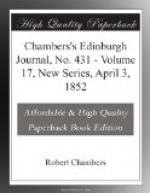is flanked on one side by a court-yard and ‘louping-on-stane;’
and on the other, by a velvety bowling-green, stretching
along to an antique garden of cut yews and hollies
overhanging the glen. It boasts, of course, its
haunted chamber, and traditional stories of love and
murder; but we have not now to do with life or death
above stairs, though many a tale might be founded
on truths ‘stranger than fiction.’
Our present purpose is with the neighbourhood of the
kitchen. There, too, we find some relics of olden
times; a fireplace which would legalise the Scottish
invitation, to ‘come in to the fire,’
inasmuch as within the chimney-arch was the seat of
honour and comfort, where a dozen cronies could sit
beside the embers, while an ox might roast in front.
From that cozy neuk did the old fiddler play in the
evening, when the spinning-wheels were put away, and
the maids, generally tenants’ daughters, had
their dance with the stragglers from the stables and
cottages. Near the kitchen was a much colder
and more dismal place, that went by the name of ’the
Pit’—a half-subterranean recess, several
steps lower than the kitchen, into which scarcely
a ray of light penetrated through the small ‘bole’
that was drilled in the massive walls for a window.
The cheerless aspect of the place seemed to confirm
the tradition, that it had sometimes served of yore
as a place of involuntary restraint. Its present
occupant, however, the son of a day-labourer, found
no fault with the accommodation it afforded him.
He was a young boy, who cleaned shoes, scoured knives,
and received with great deference the commands of
Daniel Don, the butler. This boy was called John
Dickson. The Pit was his domicile, as well as
his work-room, and he made it also a ‘study;’
for having earned a rushlight by running messages,
or doing extra work for his neighbours, he might be
found at night, as long as the light would last, poring
over a book. In this way he had, unknown to others,
while still a mere boy, read through that vast quarry
of erudition, Henry’s ‘Commentary on the
Bible.’
Old James, the gardener, was a tolerable scholar, and a well-informed man, and took great pleasure in encouraging young students; so, on discovering John Dickson’s taste for books, he lent him an old Latin grammar, recommending him to commit it to memory. This John did with praiseworthy diligence, although, being written in a language he did not understand, he could make but little use of his acquisition. Old James, however, may be forgiven for having set John to study after the orthodox fashion of Ruddiman, for he had never been out of his own glen, and in those days new ideas were long in penetrating to the country districts.




